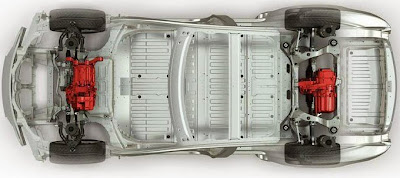At a launch event held at Hawthorne Airport in California, Tesla Motors founder and CEO Elon Musk showcased details of improvements to the Model S range. While some early predictions of a Model 3 launch were wide of the mark, the much predicted AWD version of the Model S was correct.
The ‘D’ stands for ‘dual’ motor, which has been achieved by mounting a second electric motor on the front axle. The technology will be available on the entry-level 60 kWh and standard 85 kWh cars as well as the top of the line P85.
This not only transforms the Model S into the fastest four-door production car in the world with a 0-100 km/h time of 3.2 seconds but also improves the vehicles energy efficiency. Maximim power for a P85+ with AWD (now renamed P85D) is 690 hp (508 Kw) with a peak torque of 930 Nm. Weight has increased to 2,238 kg but vehicle range is increased by 10 miles. Total range for the P85D is now 275 miles, with the 85D and 60D boasting 295 miles and 225 miles respectively.
With the addition of a second motor on the front axle the power split between the two motors is 221 hp at the front and and 470 hp at the rear (Tesla has tuned the existing unit, up from 416 hp). Cornering grip is also significantly higher than in the standard car, with a reported 1G of lateral acceleration achievable.
The AWD car’s performance improvements aren’t limited to raw pace. The extra motor allows the Model S to increase levels of regenerative braking, but the main benefit of having the two power units is improving efficiency at any given speed. Electric motors tend to reach maximum energy efficiency at close to full rated load. With the Tesla's rear drive motor being twice as powerful as any other EV on the market, at light loads it is not operating efficiency.
By plugging in a much smaller 163 kw / 300 Nm motor into the front axle, which is closer to the size of motor in the BMW i3, Tesla engineers can calibrate the powertrain to run the front motor closer to full rated load when the vehicle is driven at moderate speeds. As the Model S is limited to 60 Kw maximum brake regeneration, increasing brake bias towards the smaller front motor should also moderately increase brake regen energy efficiency.
Elon Musk mentioned the AWD powertrain will have torque vectoring but we expect this will be a friction brake controlled system much like in the Mitsubishi Outlander PHEV. Both vehicle use only 2 motors that drive the wheels via mechanical differentials so there is no way to control torque at each wheel individually via the motors.
These new digital AWD systems vastly improvement torque split front to rear compared to old inefficient analogue All-Wheel-Drive systems where front and rear axles are connected via a drive shaft, but they aren't quite there yet with side to side torque control.
First deliveries of the $120,170 Model S P85D are scheduled before the end of this year, with 85D and 60D variants arriving in February.
